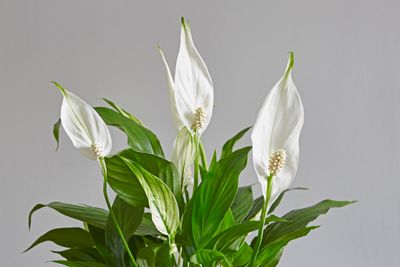Houseplants With White Flowers
The following houseplants that are white will make great additions to your home (keep in mind that this is merely a list of popular types, as there are numerous white flowering houseplants to choose from):
Peace Lily. The peace lily is a great option for houseplants with white flowers and is commonly available. They prefer lower light than most flowering houseplants and have beautifully glossy leaves, producing many white flowers (or spathes) when suitable growing conditions are met. It is also a great plant for indoor air purification. If you are looking for white houseplants with white variegated leaves, there is a variety called ‘Domino.’
Anthuriums. Some anthuriums come in white flowering varieties. These plants like warmer, brighter conditions in order to flower. The effect is well worth it though because the waxy flowers can last quite a long time.
Moth Orchid. Phalaenopsis, or moth orchids, come in many different colors, including white. These plants will typically grow new flower spikes once a year, but the floral sprays can last a few months. These plants are epiphytes, so they are typically grown in a bark mix or sphagnum moss.
Stephanotis. A more unusual white flowering houseplant to grow indoors is stephanotis. These produce beautiful waxy and fragrant white flowers. They are best grown on a trellis or post and need plenty of sunlight, water, and fertilizer for the best display.
Amaryllis. A houseplant with white flowers is the amaryllis. These are in the Hippeastrum genus. The bulbs will bloom about six to ten weeks after planting. It is important to let the foliage continue to grow for several months after blooming so that the plant can bloom again the following year. They require a lot of direct sun to ripen the leaves, and then a rest period where the bulb goes dormant again before starting the flowering cycle all over.
Holiday Cacti. Both Christmas cactus and Thanksgiving cactus come with white flowers. The flowering is triggered by shorter days and cooler nights in the fall, but with adequate growing conditions, they’ve been known to bloom more than once throughout the growing season.
